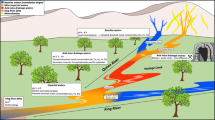Abstract
The Gorka pit lake was formed in an inactive Jurassic limestone quarry after cessation of open-pit dewatering. The main problem of the water quality in this area is linked to a large volume of extremely alkaline leachate disposed in the flooded quarry. The lake is meromictic due to a large density contrast between shallow and deep water layers. Water in the lake is of the Na–CO3–OH type, pH is in the range from 11.5 to 13.3, and there are high concentrations of sulfate and several toxic elements (Al, As, Cr, Mo, P, and V). The chemical composition of the extremely alkaline leachate was formed as a result of the groundwater interaction with the industrial red mud wastes containing 5–10 wt.% of sodium carbonate. There is a trend of increasing concentrations and pH values with depth, mainly due to the in-gassing of atmospheric CO2 into the surface layer and due to density stratification in the water column. Similar stratification is observed in groundwater wells around the lake. High dissolved concentrations of oxyanionic contaminants such as As, Cr, and V are caused by their high mobility and desorption under extremely alkaline conditions. In spite of reducing conditions at the bottom of the lake, caused by high concentrations of dumped organic matter, sulfate behaves conservatively because sulfate reducing bacteria do not survive in this pH range.






Similar content being viewed by others
References
Bethke, C. M. (2002). The Geochemist’s Workbench Ver. 4.0. Urbana, Illinois: University of Illinois.
Castro, J. M., & Moore, J. N. (2000). Pit lakes: their characteristics and the potential for their remediation. Environmental Geology, 39(11), 1254–1260.
Clark, I. D., Fritz, P., Seidlitz, H. K., Trimborn, P., Milodowski, T. E., Pearce, J. M., et al. (1993). Recarbonation of metamorphosed marls. Applied Geochemistry, 8(5), 473–481.
Cornelis, G., Johnson, C. A., Van Gerven, T., & Vandecasteele, C. (2008). Leaching mechanism of oxyanionic metalloid and metal species in alkaline solid wastes: a review. Applied Geochemistry, 23, 955–976.
Czop, M., Motyka, J., & Szuwarzyński, M. (2002). Water quality hazard in the Main Groundwater Basin (MGWB) 452 Chrzanow by leachate from industrial waste site Trzebinia–Gorka (Chrzanow area, south Poland). Gospodarka Surowcami Mineralnymi, 18(2), 105–115. in Polish.
Czop, M., Motyka, J., Szuwarzyński, M., Madej, B., & Dulewski, J. (2004). Grundwasserverschmutzungspotentiale durch alkalinisches Wasser des Industrieteiches “Górka” (Chrzanów, Sudpolen). In: Proc. of the 7th Int. Conf. DepoTech 2004, Nov. 2004, Leoben (Austria), pp 647–650 (in German).
Czop, M., Hjelmar, O., Motyka, J., Różkowski, K., & Szuwarzyński, M. (2005). Water environment hazard by extremely alkaline leachate accumulated in the „Górka” quarry (Trzebinia, S Poland). In: Proc. of 2nd Conf. “Hydrogeology of the urbanized and industrial areas”. Dec. 2005, Katowice-Sosnowiec, pp 34–41 (in Polish).
DANCEE (2003). Industrial Waste Contaminated Lake Trzebinia, Poland, Technical Note No. 3, Field Survey June 2003, Danish Environmental Protection Agency and the Ministry of Environment of Poland.
Drever, J. I. (1997). The geochemistry of natural waters. Surface and groundwater environments. Upper Saddle River, NJ: Prentice Hall. 07458.
Jellison, R., Romero, J., & Melack, J. M. (1998). The onset of meromixis during restoration of Mono Lake, California: unintended consequences of reducing water diversions. Limnology and Oceanography, 43, 706–711.
Khoury, H. N., Salameh, E., & Abdul-Jaber, Q. (1985). Characteristics of an unusually highly alkaline water from the Maqarin are Northern Jordania. Journal of Hydrology, 81(1–2), 79–91.
Kirk, M. F., Holm, T. R., Park, J., Jin, Q., Sanford, R. A., Fouke, B. W., et al. (2004). Bacterial sulfate reduction limits natural arsenic contamination in groundwater. Geology, 32(11), 953–956.
Kolker, A., & Huggins, F. E. (2007). Progressive oxidation of pyrite in five bituminous coal samples: an as XANES and 57Fe Mössbauer spectroscopic study. Applied Geochemistry, 22(4), 778–787.
Kolker, A., Huggins, F. E., Palmer, C. A., Shah, N., Crowley, S. S., & Huffman, G. P. (2000). Mode of occurrence of arsenic in four US coals. Fuel Processing Technology, 63(2–3), 167–178.
Langmuir, D. (1997). Aqueous environmental geochemistry. Upper Saddle River, NJ: Prentice Hall. 07458.
Marques, J. M., Carreira, P. M., Carvalho, M. R., Matias, M. J., Goff, F. E., Basto, M. J., et al. (2008). Origins of high pH mineral waters from ultramafic rocks, Central Portugal. Applied Geochemistry, 23(12), 3278–3289.
Pellicori, D. A., Gammons, C. H., & Poulson, S. R. (2005). Geochemistry and stable isotope composition of the Berkeley pit lake and surrounding mine waters, Butte, Montana, Applied Geochemistry, 20, 2116–2137.
Roadcap, G. S., Kelly, W. R., & Bethke, C. M. (2005). Geochemistry of extremely alkaline (pH > 12) ground water in slag-fill aquifers. Ground Water, 43(6), 806–816.
Roadcap, G. S., Sanford, R. A., Qusheng, J., Pardinas, J. R., & Bethke, C. M. (2006). Extremely alkaline (pH > 12) ground water hosts diverse microbial community. Ground Water, 44(4), 511–517.
Stumm, W. (1992). Chemistry of solid-water interface. New York: Wiley-Interscience.
Acknowledgments
This work was supported by research program no. 11.11.140.139 of the Faculty of Geology, Geophysics and Environmental Protection, Department of Hydrogeology and Engineering Geology, AGH-University of Science and Technology, Krakow. We thank an anonymous reviewer for useful suggestions and editorial changes, which improved the manuscript.
Author information
Authors and Affiliations
Corresponding author
Rights and permissions
About this article
Cite this article
Czop, M., Motyka, J., Sracek, O. et al. Geochemistry of the Hyperalkaline Gorka Pit Lake (pH > 13) in the Chrzanow Region, Southern Poland. Water Air Soil Pollut 214, 423–434 (2011). https://doi.org/10.1007/s11270-010-0433-x
Received:
Accepted:
Published:
Issue Date:
DOI: https://doi.org/10.1007/s11270-010-0433-x




